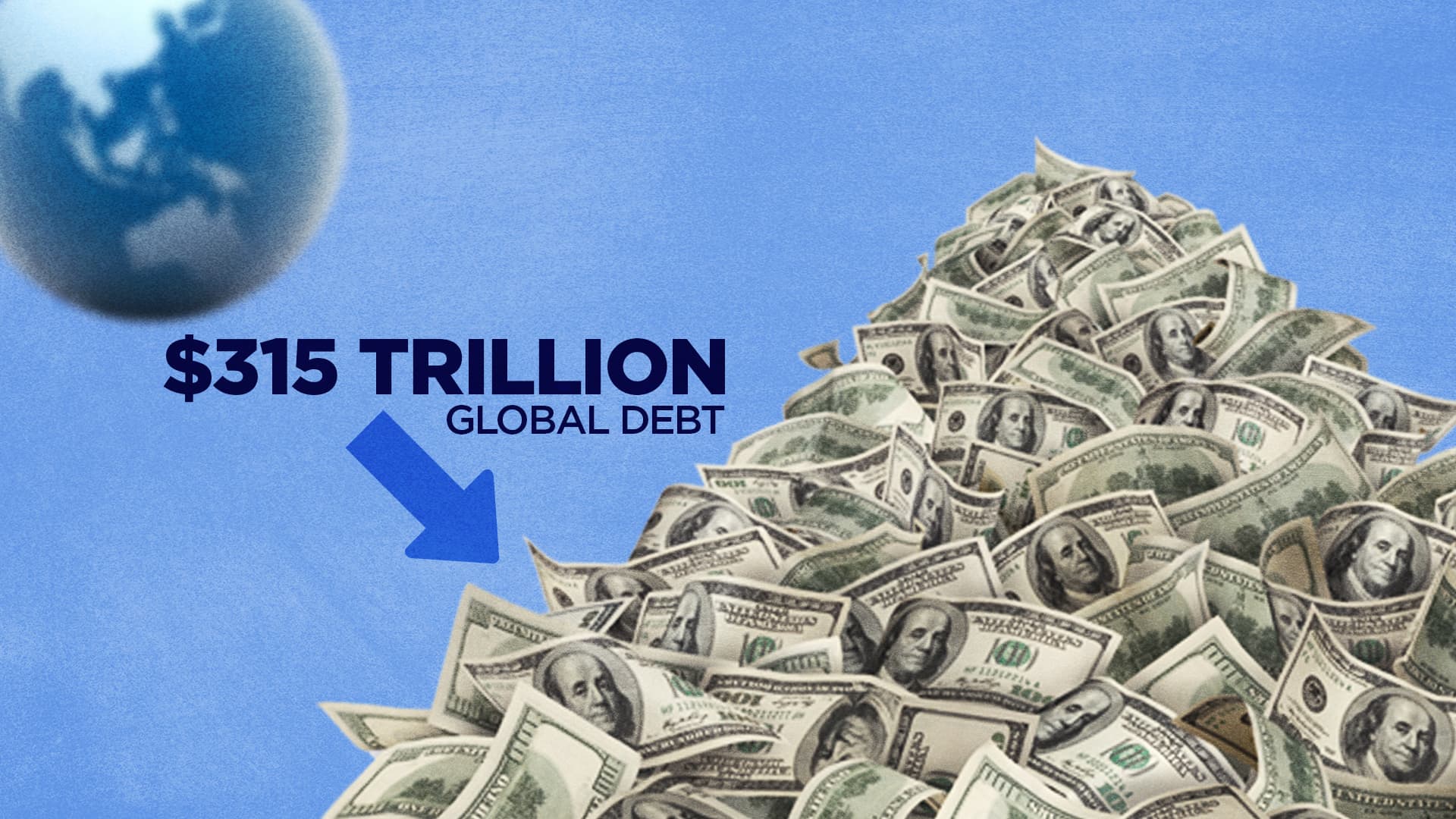Here is a transcript of the video.
The world is in debt. To the tune of $315 trillion and counting.
$315 trillion is a staggering number to visualize but consider this. In 2024, global gross domestic product — or GDP — amounted to $109.5 trillion dollars — slightly over a third of that global debt number.
Another way to picture it? There are about 8.1 billion of us living in the world today. If we were to divide that debt up by person, each of us would owe about $39,000.
So, with global debt at a record high, should you be concerned? And how did we get here in the first place?
Global debt combines borrowings from households, businesses and governments.
You’re probably most familiar with household debt, which includes things like mortgages, credit card and student debt. At the beginning of 2024, this amounted to $59.1 trillion.
Business debt, which corporations use to finance their operations and growth, sat at $164.5 trillion, with the financial sector alone making up $70.4 trillion of that amount.
Finally, there’s government debt, which is used to help fund public services and projects without raising taxes.
Countries can borrow from each other or from global institutions such as the World Bank and the International Monetary Fund.
But governments can also raise money by selling bonds… which is essentially an IOU from the state to investors. And like all loans, it includes interest.
Public debt stood at $91.4 trillion. While debt may have a bad rap, it isn’t necessarily a bad thing. It could help an individual get an education or join the property ladder. It enables businesses to start up and scale up. And though national debt is the most contentious of the three, it can give governments the leverage they need to build the economy, for social spending, or respond to a crisis.
Written record shows public debt has been around for at least 2,000 years, primarily used to establish towns, cities, states and nations… and to fund wars. Governments have long amassed heavy debts from wartime expenses, such as the Napoleonic Wars, Franco-Prussian War and U.S. Civil War in the 19th century.
World War II, the most expensive war in history, triggered several debt crises, with most of the outstanding loans being owed to the United States.
Since the 1950s, there have been four major waves of debt accumulation.
The first debt wave originated from Latin America in the 1980s, which led 16 countries in that region to restructure their borrowings.
The second wave impacted Southeast Asia at the turn of the 21st century, while the U.S. and Europe took the brunt of the third global debt wave during the 2007–2008 global financial crisis.
We are now in the fourth wave, which began in 2010, and coincided with the Covid-19 pandemic. Governments had to take on even more debt to help businesses and its citizens cushion the impact of lockdowns.
Global debt rose to 256 percent of GDP in 2020, a 28-percentage point increase – and the biggest one-year debt rise since the Second World War.
But the pandemic just exacerbated a problem that was already there. Debt had been piling up for at least a decade before, as individuals, companies and governments spent beyond their means. Just look at this graph from the World Bank, which shows debt as a percentage of GDP, rapidly climbing from 2008.
This brings us to a critical question: how much debt is too much debt? When does it become unsustainable?
Put simply, it’s when you can no longer afford it.
So, for example, when a government is forced to make cuts in areas that hurt its people, such as education or healthcare, just to keep up with payments.
Take Zambia for instance. In 2021, debt servicing accounted for 39% of its national budget. That year, the government spent more on paying these debts than education, health, water and sanitation combined. And it’s completely hampered the nation’s ability to invest in its future.
Debt-to-GDP ratio is the economic metric that compares a country’s government debt to its gross domestic product. It’s usually presented as a percentage and is seen as a good indicator of that country’s ability to service its debts.
So, let’s pretend we have two countries, each with $30 billion in debt. Sounds like they have the same problem, right? But if it turns out that one of those countries has a $30 billion economy, and the other has a nearly $30 trillion economy, it’s clear which country is shouldering the bigger debt burden.
This, often coupled with unfavorable foreign exchange and interest rates, is why debt is seen as riskier for smaller economies.
But there are, of course, exceptions.
Japan, the world’s fourth largest economy, is also one of the world’s most indebted countries, with total debt sitting above 600% of GDP. And while the bulk of Japan’s debt is public, in recent years, it has been the financial sector piling on – not the government.
Around two-thirds of the $315 trillion owed originates from mature economies with Japan and the United States contributing the most to that debt pile. But generally, the debt-to-GDP ratio for mature economies has been coming down.
On the other hand, emerging markets held $105 trillion in debt, but the EM debt-to-GDP ratio hit a new high of 257% – pushing the overall ratio up for the first time in three years. China, India and Mexico were the biggest contributors.
The fourth wave has been the biggest, fastest and most wide-ranging rise in debt we’ve seen since World War II. Better policies and financial regulations have kept a far-reaching debt crisis at bay.
But with so much money on the line, the prospect of a stronger dollar or a trade war could be enough to tip a country – or several – into default.















